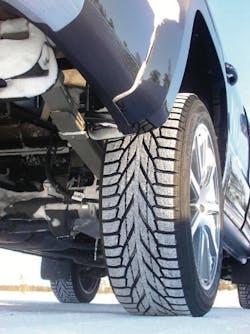Nokian Tyres plc is not the largest tire manufacturer in the world by a wide sales margin. However, it arguably is the most profitable.
And it intends to remain that way. It continues to cater to its core markets: Scandinavia, Russia, Central Europe and, to a lesser extent, North America.
“Profit is more important to us than volume,” says Hannu Teininen, vice president of sales and logistics.
Supply isn’t a problem, however. To meet demand, Nokian is introducing new products and increasing capacity.
Its 99-year-old plant in Nokia, Finland, can produce six million consumer tires annually. Its eight-year-old plant in St. Petersburg, Russia, can produce 15 million tires annually. Between the two plants, there are 11 automated tire building machines, designed by Nokian in cooperation with VMI Holland B.V.
“We are ready to expand the Russian capacity to 20 million or more rather rapidly,” says Teininen. In addition, the site for a third plant, which would be located somewhere in Europe (but not Finland), will be built “whenever it is needed.” When Nokian breaks ground on its third plant, it will take almost two years before it is up and running.
Nokian only manufactures replacement tires. “We don’t want to be an OE supplier,” says Teininen. “We’re a small company. We don’t have the capacity.”
The company recorded net income of close to $437.7 million on record net sales of $2.1 billion in 2012. Sales in the United States and Canada represent 7% of total sales. Nokian’s operating profit was up 9.2%, and its income-to-sales ratio was 21%.
Winter 2013-14
Nokian is introducing three next-generation winter tires in North America this year for the 2013-14 winter season: the Hakkapeliitta R2, Hakkapeliitta R2 SUV and WR G3. They combine snow and ice traction with silica-based compounding for low rolling resistance. They are available through the parent company’s North American subsidiary, Nokian Tyres Inc.
[PAGEBREAK]
1. Hakkapeliitta R2. Like the tire it is designed to replace, the Hakkapeliitta R, the non-studded R2 features a directional tread pattern. It has superior ice and snow grip thanks to improved compounding and siping design, including dense sipes at different angles in the shoulder area. The new compound also contains millions of sharp particles for traction. The company says it hopes to patent this “Cryo Crystal Concept” technology.
Although Nokian declines to reveal what the particles are made of, Matti Morri, technical customer service manager, says corn, rice and walnut shells aren’t involved. The particles remain part of the compound down to 4/32-inch tread depth, the minimum allowable tread depth in Finland.
The Hakkapeliitta R2 will be available in 55 R-rated sizes ranging from 175/70R13 82R through 255/35R20 97R. Forty-four of the sizes are XL; nine are run-flat, including 245/45R18 100R XL Run-Flat.
2. Hakkapeliitta R2 SUV. Designed for SUVs and 4x4s, the non-studded tire has different compounding and stronger steel belts than the R2 because it requires greater stability, according to Morri. It, too, utilizes Cryo Crystals.
The tread pattern features a stiff center rib with a Driving Safety Indicator that tells the driver when 4/32-inch has been reached. It will be available in 38 R-rated sizes ranging from 235/75R15 105R through 255/55R19 111R XL. That includes two run-flat sizes: 225/60R17 99R and 255/50R19 107R XL.
3. WR G3. Available in two tread patterns, asymmetric and directional, the WR G3 is an all-season high performance tire with a mountain snowflake severe service emblem on its sidewall. It has different compounding than its European counterparts, resulting in better mileage and handling for the North American market.
The first wave of asymmetric sizes for the WR G3 will include 25 XL sizes ranging from 205/65R16 99 H through 245/40R18 97V. There also will be two run-flat sizes: 205/55R16 91H and 205/45R17 91H. The six sizes for the directional WR G3 range from 175/65R14 82T to 195/55R15 89V XL.
Nokian says both WR G3 designs have “excellent slush and aquaplaning properties” and were manufactured with “Silent Sidewall Technology” (less vibration in the bead area). The technology also was used to produce the Hakkapeliitta 8, which will be available in the U.S. next year.
Nokian tests all its winter tires at its Ivalo testing center in Finnish Lapland, 200 miles north of the Arctic Circle. The company does not rent out the facility to any other tire manufacturer; that includes Bridgestone Corp., which owns 15% of Nokian. ■
[PAGEBREAK]
Nokian Tyres: moments in time
2007: Nokian acquires Goss Tire Co. retail stores in Vermont; 35 of the company’s 1,037 Vianor retail locations worldwide are located in the New England area.
2005: Nokian acquires University Wholesalers in the U.S. in September.
2005: A second tire plant is opened in Vsevolozhsk, Russia.
1995: Nokian Tyres plc splits off from Nokia Corp.
1988: Nokia Tyres Ltd. is established as a joint venture.
1987: The Vianor company-owned store chain begins in Norway.
1967: Finnish Rubber Works merges into Nokia Corp.
1936: The first Hakkapeliitta tire is manufactured.
1934: The first winter tire is manufactured.
1932: Car tire production begins.
1904: FRW’s first plant is opened in Nokia, Finland.
1898: Finnish Rubber Works (FRW), the forefather of Nokian Tyres, is founded.




